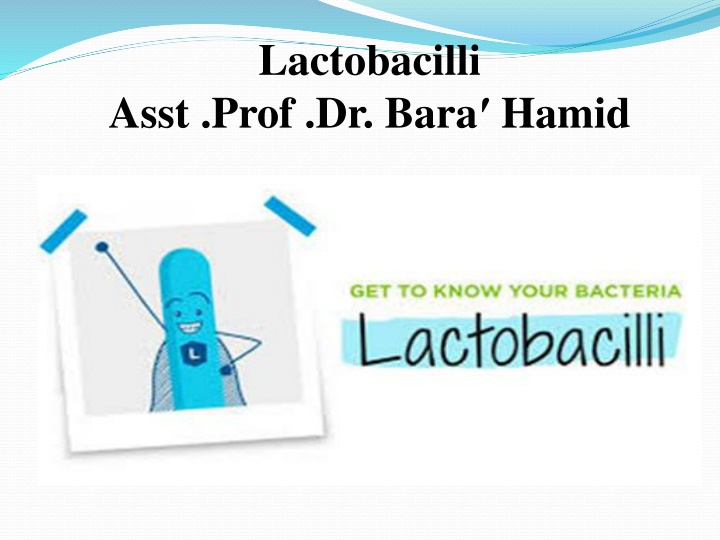
Lactobacilli: Characteristics, Habitat, and Pathogenicity
Explore the complex taxonomy of Lactobacilli, their presence in different body parts, and their role in causing dental caries. Learn about their fermentation abilities, acidic tolerance, and importance in maintaining microbial balance in the body.
Download Presentation

Please find below an Image/Link to download the presentation.
The content on the website is provided AS IS for your information and personal use only. It may not be sold, licensed, or shared on other websites without obtaining consent from the author. If you encounter any issues during the download, it is possible that the publisher has removed the file from their server.
You are allowed to download the files provided on this website for personal or commercial use, subject to the condition that they are used lawfully. All files are the property of their respective owners.
The content on the website is provided AS IS for your information and personal use only. It may not be sold, licensed, or shared on other websites without obtaining consent from the author.
E N D
Presentation Transcript
Lactobacilli Asst .Prof .Dr. Bara Hamid
Lactobacilli Lactobacilli are saprophytes in vegetable and animal material (e.g. milk). Some species are common animal and human commensals inhabiting the oral cavity and other parts of the body. They have the ability to tolerate acidic environments and hence are believed to be associated with the carious process.
The taxonomy of lactobacilli is complex: They are characterized into two main groups: Homofermenters: which produce mainly lactic acid (65%) from glucose fermentation (e.g. Lactobacillus casei). Heterofermenters: which produce lactic acid as well as acetate, ethanol and carbon dioxide (e.g. Lactobacillus fermentum). L. casei and Lactobacillus rhamnosus, Lactobacillus acidophilus and the newly described species, Lactobacillus oris, are common in the oral cavity
Habitat and transmission Lactobacilli are found in the oral cavity, gastrointestinal tract and female genital tract. In the oral cavity, they constitute less than 1% of the total flora.
Characteristics: Gram-positive coccobacillary forms (mostly bacillary), - or non-haemolytic, facultative anaerobes non spore forming. These organisms ferment carbohydrates to form acids (i.e. they are acidogenic) and can survive well in acidic milieu (they are aciduric); they may be homofermentative or heterofermentative. The question as to whether they are present in carious lesions because they prefer the acidic environment, or whether they generate an acidic milieu and destroy the tooth enamel.
Lactobacilli are also major constituents of the vaginal flora and help maintain its low pH equilibrium. Recently, the beneficial role of lactobacilli is maintaining the homoeostasis of the intestinal flora.
Culture and identification Lactobacilli grow under microaerophilic conditions in the presence of carbon dioxide and at acidic pH (6.0). Media enriched with glucose or blood promote growth. A special selective medium, tomato juice agar (pH 5.0), rogosa agar promote the growth of lactobacilli while suppressing other bacteria. Identification is by biochemical reactions.
Pathogenicity :Lactobacilli cause: Dental caries Bacterial vaginosis Lactobacilli and carious lesions Lactobacilli are frequently isolated from deep carious lesions where the pH tends to be acidic. Indeed, early workers believed that lactobacilli were the main cariogenic agent (a theory that has been disproved), so much so that the number of lactobacilli in saliva (the lactobacillus count) was taken as an indication of an individual s caries activity (Caries test). Although this test is not very reliable, it is useful for monitoring the dietary profile of a patient because the level of lactobacilli correlates well with the intake of dietary carbohydrate.
TREATMENT Lactobacilli are sensitive to penicillin and clindamycin
Probiotics: Commercial preparations of lactobacilli are used as probiotics to restore normal flora after the imbalance created by antibiotic therapy. actobacillus acidophilus has been used in alternative medicine as a possibly effective aid (in children or adults) in preventing diarrhea caused by antibiotics, travel, chemotherapy, or hospitalization.
Lactobacillus acidophilus is also possibly effective in treating irritable bowel syndrome, bacterial vaginal infection, colic in babies, lung infections in children, skin problems in children who are allergic to milk, and other conditions. Lactobacillus acidophilus has also been used to treat lactose intolerance, Crohn's disease, overgrowth of bacteria in the intestines, or vaginal yeast infections caused by antibiotics.





















